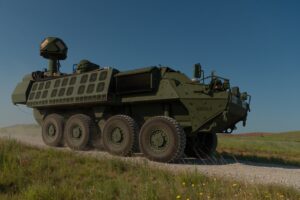The Army has now received the first three Stryker-mounted 50-kilowatt laser systems, an official confirmed on Wednesday, with the fourth and final prototype to be delivered “within the next month.”
Lt. Gen. Robert Rasch, director of the Army’s Rapid Capabilities and Critical Technologies Office (RCCTO), provided the update on the Directed Energy Maneuver Short-Range Air Defense (DE M-SHORAD) effort and signaled there could be additional prototyping work to further inform the eventual program of record.

“We have to do another round of prototyping so that we can focus on the things that will help inform that longer-term decision, like lethality. We need to collect the data to really validate the models that we’ve been using for directed energy development for a number of years. But really, how do we get that producibility?” Rasch said during remarks at the Space & Missile Defense Symposium in Huntsville, Alabama. “And from producibility, how do we get reliability out of the system?…And then both of those both lead to the big elephant in the directed energy room called affordability.”
The RCCTO-led DE M-SHORAD program aims to deliver an on-the-move laser system capable of taking down unmanned aerial systems, rotary-wing aircraft and rockets, artillery and mortars.
Currently, the program is focused on a prototyping effort with RTX [RTX] providing the laser and beam director and Kord Technologies serving as the laser module integrator.
Rasch told Defense Daily in late March that DE M-SHORAD is on path for a user assessment in early fiscal year 2024 and could potentially transition into a program of record and a competitive effort for production around FY ‘25 or ‘26 (Defense Daily, March 30).
“We’re getting that capability out and really pushing industry to work on the integration readiness level of these technologies in a small form factor to get on that platform,” Rasch said on Wednesday.
After fielding the fourth DE M-SHORAD system, Rasch said the focus will turn to developing tactics, techniques and procedures for the laser weapon.
“We’re kind of taking a dual path with the Army. What we don’t know yet for directed energy systems, necessarily, is how to fight them, how to fight lasers on the battlefield, how to integrate kinetic and non-kinetic effectors…into the battlespace,” Rasch said. “We’re doing directed energy because we don’t have the magazine depth, and quite frankly can’t afford the magazine depth, to have missiles everywhere we want. So having the capability of directed energy to provide that kind of renewable kill power on a platform is very appealing. But it’s got to be affordable [and] it’s got to be reliable.”
Rasch noted the unit receiving the DE M-SHORAD prototypes will also get the kinetic M-SHORAD system as it works through testing.
“[That’s] so we can get out and test it together and find out what’s the right mix. What’s the right mix of counter-UAS or Maneuver-SHORAD capability to support that maneuvering formation?” Rasch said.
Leonardo DRS supplies the mission equipment package for M-SHORAD, which includes the Moog [MOG.A] Reconfigurable Integrated-weapons Platform (RIwP) turret, the XM914 30mm cannon and M240 machine gun, Stinger and Hellfire missiles and Rada USA’s Multi-Mission Hemispheric Radar, with GD Land Systems [GD] integrating the capability on select Strykers.
Following the DE M-SHORAD prototyping effort, RCCTO is expected to transition the program to the Army’s Program Executive Office for Missiles and Space, which would oversee the potential competition for production.
Lockheed Martin [LMT] has previously detailed its Directed Energy Interceptor for the Maneuver Short-Range Air Defense System (DEIMOS) system that it’s looking to offer for the future DE M-SHORAD competition, achieving “first light” of its 50-kilowatt laser capability in January (Defense Daily, Jan. 23).